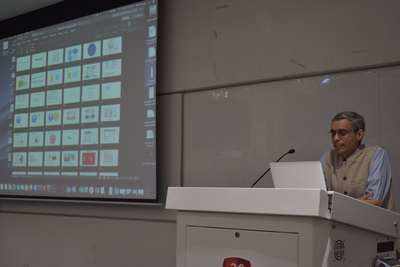Journalists need to be storytellers now: Rohit Saran

By Tejaswini Mittal
“One of the key challenges that we all face in the newsroom today is transitioning from a journalist to a storyteller,” saidThe Times of India Managing Editor, Rohit Saran while addressing the students of Times School of Media at Bennett University on January 17.
“The world and technology are changing so fast, storytelling is changing so fast. So, what kind of mindset and skills do you need to be a complete storyteller?” he asked.
Answering his own question, he listed the following as the main elements of storytelling:
1. Screen: Everything is a screen, and everything is in that screen. One is always catering to a screen. “Despite many reports on how screen time must be reduced, the reality is that screen time for people is only going to increase. If you are a storyteller for a screen, you can tell richer and better stories”
2. Interface: Where screen comes in, interface changes. One can access anything from anywhere or communicate with anyone from any corner of the world on a screen, be it a phone screen or a computer screen.
3. Sharing: The audience is now distributing the storyteller’s content more than the storyteller himself.
4. Flowing: For a journalist, the biggest change in moving to screens is that everything is flowing in a continuous stream, non-stop. There’s always a deadline, every second that passes is the deadline. The term flowing means that the consumer expects new information all the time, which is different from the previous data.
5. Access: “This side of storytelling is putting journalism in complete turmoil,” says Saran. “Earlier, people used to pay for ownership of content, but now they just want access to it.” According to him, content must lie somewhere, where anyone can access it at any time. “Pricing to access has been disrupted, because how do you price access?”
6. Self-generating content: “People nowadays expect self-generating content. They want extra information than what has been provided, the sources to which can be mentioned within the data,” Saran suggests. Here, the storyteller needs to have enough depth of knowledge of the story he or she is doing and needs to question him/herself how long he/she plans to stay with the story/topic.
Saran said that storytelling has three layers today -- news, knowledge and wisdom. “The objective is to combine all three, and add knowledge and wisdom to the news in the most exciting manner.”
“One of the key challenges that we all face in the newsroom today is transitioning from a journalist to a storyteller,” said
“The world and technology are changing so fast, storytelling is changing so fast. So, what kind of mindset and skills do you need to be a complete storyteller?” he asked.
Answering his own question, he listed the following as the main elements of storytelling:
1. Screen: Everything is a screen, and everything is in that screen. One is always catering to a screen. “Despite many reports on how screen time must be reduced, the reality is that screen time for people is only going to increase. If you are a storyteller for a screen, you can tell richer and better stories”
2. Interface: Where screen comes in, interface changes. One can access anything from anywhere or communicate with anyone from any corner of the world on a screen, be it a phone screen or a computer screen.
3. Sharing: The audience is now distributing the storyteller’s content more than the storyteller himself.
4. Flowing: For a journalist, the biggest change in moving to screens is that everything is flowing in a continuous stream, non-stop. There’s always a deadline, every second that passes is the deadline. The term flowing means that the consumer expects new information all the time, which is different from the previous data.
5. Access: “This side of storytelling is putting journalism in complete turmoil,” says Saran. “Earlier, people used to pay for ownership of content, but now they just want access to it.” According to him, content must lie somewhere, where anyone can access it at any time. “Pricing to access has been disrupted, because how do you price access?”
6. Self-generating content: “People nowadays expect self-generating content. They want extra information than what has been provided, the sources to which can be mentioned within the data,” Saran suggests. Here, the storyteller needs to have enough depth of knowledge of the story he or she is doing and needs to question him/herself how long he/she plans to stay with the story/topic.
Saran said that storytelling has three layers today -- news, knowledge and wisdom. “The objective is to combine all three, and add knowledge and wisdom to the news in the most exciting manner.”










Recent Messages ()
Please rate before posting your Review
SIGN IN WITH
Refrain from posting comments that are obscene, defamatory or inflammatory, and do not indulge in personal attacks, name calling or inciting hatred against any community. Help us delete comments that do not follow these guidelines by marking them offensive. Let's work together to keep the conversation civil.